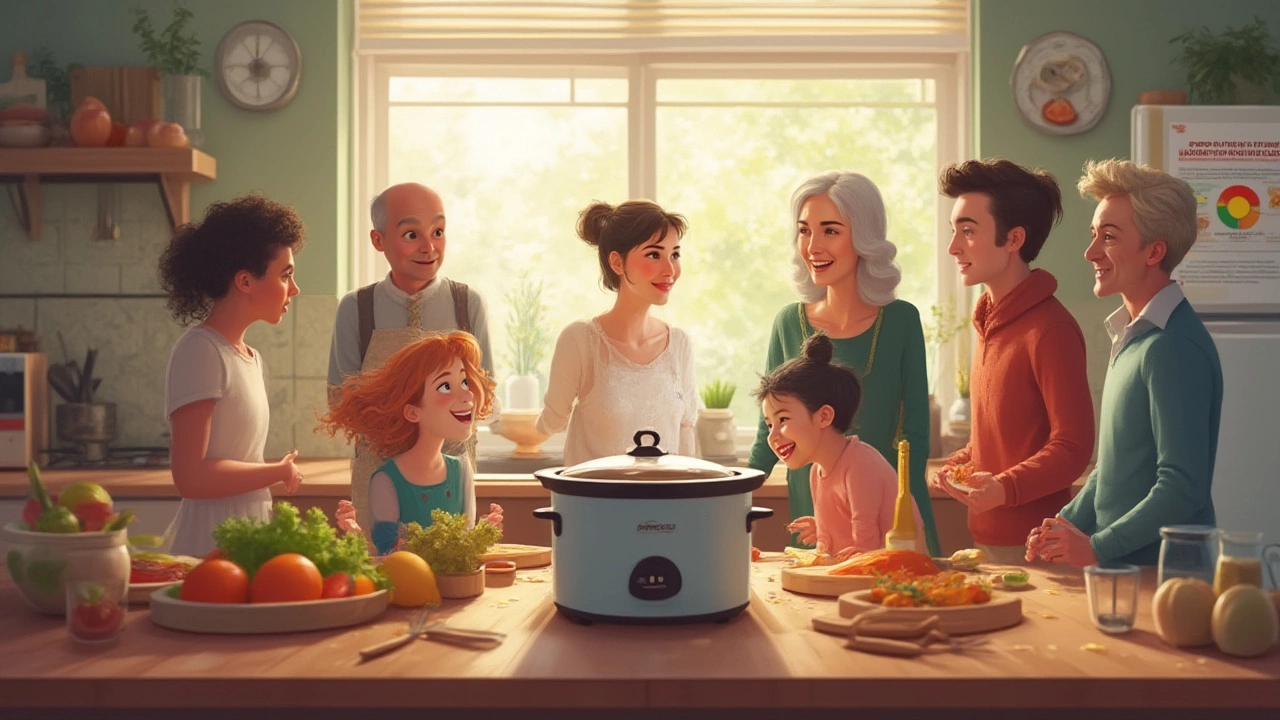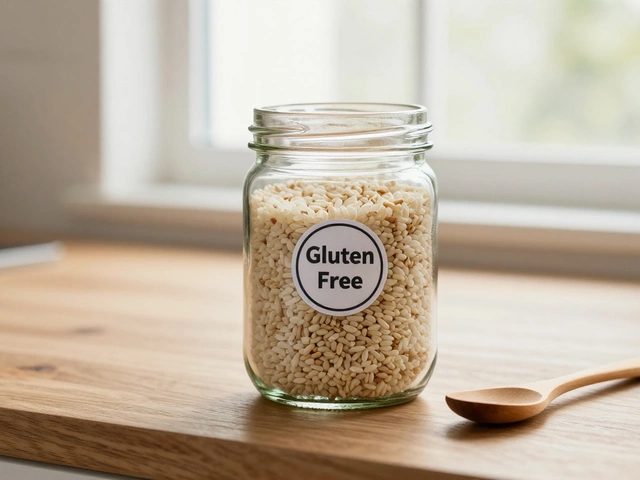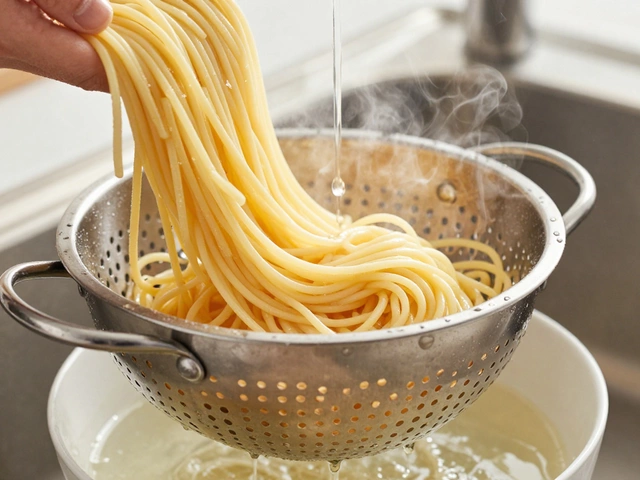There’s a not-so-secret world hiding in your Crockpot, and it’s not the recipe simmering away. It’s a temperature range with a reputation: the "danger zone." Sliding just a few degrees into this spot could mean bacteria multiplying in your dinner, even as the house fills with that irresistible, slow-cooked aroma. But the real kicker? Most folks using a slow cooker don’t even realize how easily food can hang out in the wrong zone and tip from perfect to risky.
What the Danger Zone Means in Crockpot Cooking
First, let’s talk numbers. The "danger zone" in food safety isn’t a mythical place—it's between 40°F (4°C) and 140°F (60°C). This temperature bracket is where troublesome bacteria known as pathogens (think Salmonella, Staph aureus, and others) thrive and multiply at alarming rates. The USDA didn’t just pick this range for fun. At temps above 140°F, most bacteria start to die off. Below 40°F? They either grow way slower or not at all. The trouble is, Crockpots—especially older models or when improperly used—can sometimes linger right in the danger zone instead of heating fast enough.
Now, if you set your Crockpot correctly and don’t overload it, it’s designed to bump the food up above 140°F safely, even on the low setting. But loading up a cold insert with refrigerated ingredients or forgetting to thaw your meat before cooking? That can leave some foods hanging at those dangerous temperatures for hours. A famous food safety case that still gets rehashed at food safety conferences involved slow-cooked chili at a church fundraiser that didn’t hit a safe internal temp for four hours. The result? Dozens with food poisoning. Ouch.
And here's the thing—the danger zone isn’t just about how hot your food is, but how long it sits there. The "two-hour rule" says food should not stay in this range for more than two hours, or just one hour if it’s hot out. The longer bacteria get to play in this band, the better their chances of making you sick. Crockpots, because of their slow heating cycle, need a little help from you to keep food out of the danger zone.
So keep this in mind every time you dust off your slow cooker for pulled pork or stew: the danger zone is real, and timing is everything. Do you know if your slow cooker heats fast enough? Many don’t, especially if you love a bargain and picked one up at a yard sale that’s older than you are. That brings us to why understanding this danger zone is every bit as important as seasoning your Sunday roast just right.
Why Slow Cookers Sometimes Slip into the Danger Zone
Slow cookers are basically designed to do exactly what their name says: cook slowly. But that built-in feature is also their biggest food safety red flag. Old, cheap, or even well-loved modern Crockpots may take longer to reach the safe threshold of 140°F than official guidelines prefer. On ‘Low’ settings, most modern Crockpots hit 209°F after a few hours and keep things below a full boil, but there can be a gap—a couple of hours spent between refrigerator-cold and safe-and-hot. That’s the danger zone.
Here’s where most people get tripped up: the temptation to throw frozen meat or a fridge-cold roast straight into the pot and turn it on ‘Low.’ That seems fine (and sometimes tastes just as good), but the research tells us frozen or cold meats can sit squarely in the danger zone for hours before the internal temp finally climbs to safety. The rate at which your slow cooker heats depends on the size and type of your Crockpot, the starting temperature of your ingredients, and how full you load it.
If you overfill your Crockpot, pack it with raw veggies sitting under a cold roast, and then set it on ‘Low,’ you’re practically inviting bacteria over for a feast. When measured in USDA studies, heavy, crowded Crockpot setups might not climb out of the danger zone for up to four hours. That’s a long time for bacteria to set up shop. It’s also why experts and manufacturers now say you should thaw all meats thoroughly before slow cooking and avoid overloading the pot. Not just for even cooking, but because of safety zones like these.
Here’s something a little scary—some older Crockpots never get food hotter than about 180°F, especially on ‘Low’ if the lid isn’t on tight. At that temperature, it technically works, but edges of the pot can be hotter than what’s in the middle, meaning uneven cooking and more time spent in the danger zone. That’s why it’s best to rotate or stir food during the first hour of cooking if you’re nervous about your model. If you’re still using a hand-me-down slow cooker from decades ago, consider buying a food thermometer and checking if those settings deliver what they promise.
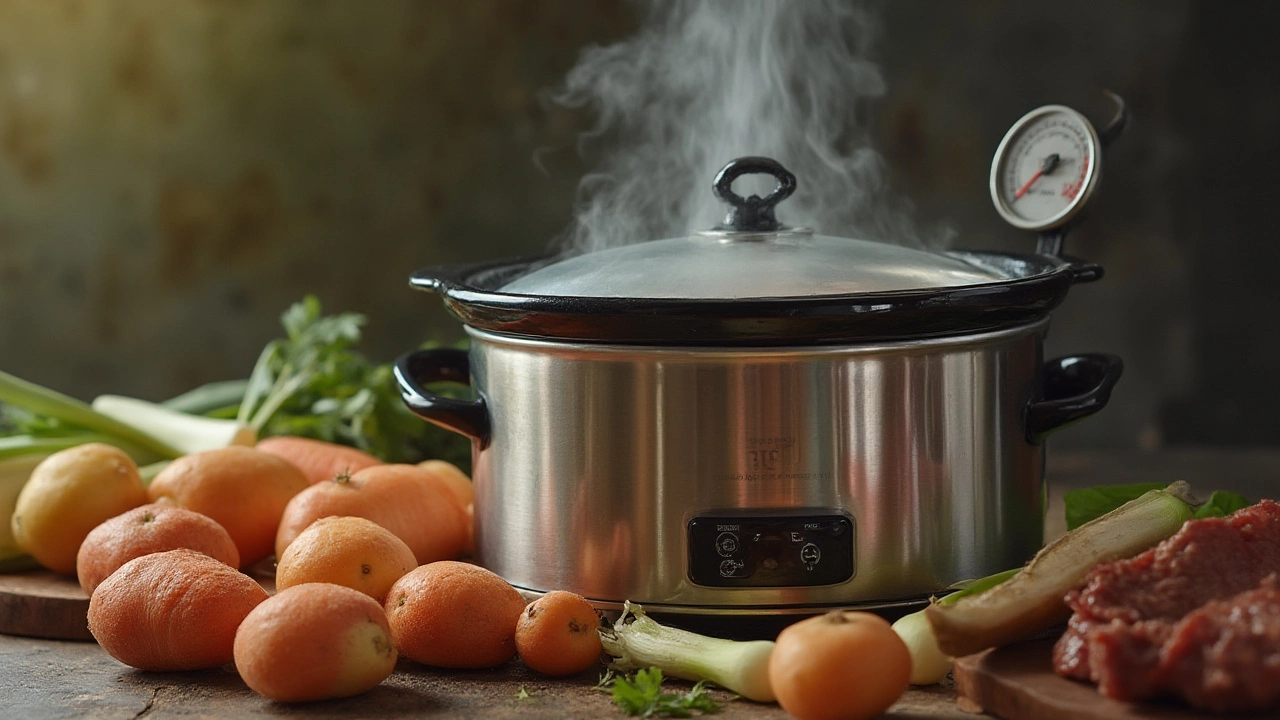
How to Keep Your Crockpot Safe: Practical Tips
If you want to keep eating slow-cooked meals (and who doesn’t?), you don’t have to give up your Crockpot. You just need some solid, practical habits to keep your food safe. First, always thaw meat and poultry before adding them to a slow cooker. Sure, it’s tempting to dump in a frozen block of chicken at 7 a.m.—but that move almost guarantees hours in the danger zone. Give your meats a night in the fridge or use the microwave’s defrost setting. It might take you an extra five minutes, but you’ll save yourself hours of stomach pain later.
Second, don’t overload the pot. Fill your Crockpot between half and two-thirds full. More than that, and things heat up slower, especially the center. Underfilling isn’t much better; food can burn or dry out quickly. The manufacturers and the USDA both back these filling guidelines. And here’s an easy hack: if you’re cooking a hunk of meat that fills the pot almost to the top, cut it into smaller pieces. More surface area means quicker, more even heating.
Speaking of even heating, placing vegetables on the bottom of the slow cooker, with the meat on top, is the way to go. The heating element is usually at the base, so root veggies like carrots and potatoes cook best there. Letting them soak-up the first bursts of heat helps bring the temperature up fast. Toss the lid on right away and don’t keep checking—lifting the lid can drop the temp by up to 10-15°F and add a good 20 minutes to your cooking time. Get all your stirring and seasoning done at the start.
Next, if you’re ever in doubt, grab a food thermometer. You’re aiming for a minimum of 165°F in the thickest part of the food by halfway through cooking, and 140°F should be hit during the first two hours. No thermometer? You can pick one up for less than $15 at pretty much any grocery store. They’re dead simple to use, but they might just save you from a miserable night clutching your stomach.
- Thaw all meat and poultry before slow cooking.
- Preheat if the recipe calls for it—add hot (not boiling) liquid to the Crockpot for stews and soups.
- Keep the lid on as much as possible.
- Use a thermometer to check internal temps.
- Store leftovers within two hours after cooking—don’t keep food on the ‘Warm’ setting for more than four hours.
And if you ever have to interrupt the cooking (say, the power goes out), don’t risk it. If the food hasn't reached 140°F yet, toss it. Your peace of mind—and health—are worth more than the cost of a chuck roast.
What the USDA and Crockpot Makers Say
It’s not just home cooks who worry about the danger zone—the U.S. Department of Agriculture takes Crockpot cooking seriously too. Their food safety experts have studied slow cookers since the 1980s, long before they were Instagrammable. Their advice is simple: Crockpots are safe as long as you use them right.
The USDA’s gold standard is this: food in a slow cooker should reach 140°F (60°C) within two hours. And ‘hot holding’—keeping food warm for parties or meals later—should always be above 140°F. Manufacturers have basically baked these recommendations right into their user manuals now. The manual often says, "Do not cook food from frozen," and "Never use on warm to cook food from scratch." On top of that, the ‘Warm’ setting keeps food above 140°F, but it’s not hot enough to actually cook anything safely. So, no shortcuts—don’t use ‘Warm’ thinking it’ll cook your breakfast oatmeal by lunchtime.
Another solid point: Crockpot makers have tested models using both filled-to-the-brim and only-half-full set-ups during their lab runs, and noticed pretty big differences in timing and safe heating. So, when a recipe states, "cook on Low for eight hours," it assumes the pot’s loaded the right way.
If you’ve got an older slow cooker, the USDA and many food scientists recommend you test it yourself. Fill your Crockpot with 2 quarts of water, set it to Low, and let it run for eight hours with the lid on. At the end, check the water with a thermometer. If it’s above 185°F, you’re in good shape. If not, it might be time for a new one or consider cooking only recipes that have a short time in the danger zone—like soups or stews heavy on broth, where liquid heats up quickly.
Here’s a wild fact: In a study cited by food safety researchers in 2019, about 25% of slow cookers tested in consumer kitchens ran on the cooler side and needed extra time to bring food out of the danger zone—even newer models with lots of bells and whistles. Bottom line, no matter how new your Crockpot, give it a test run and keep a food thermometer handy.
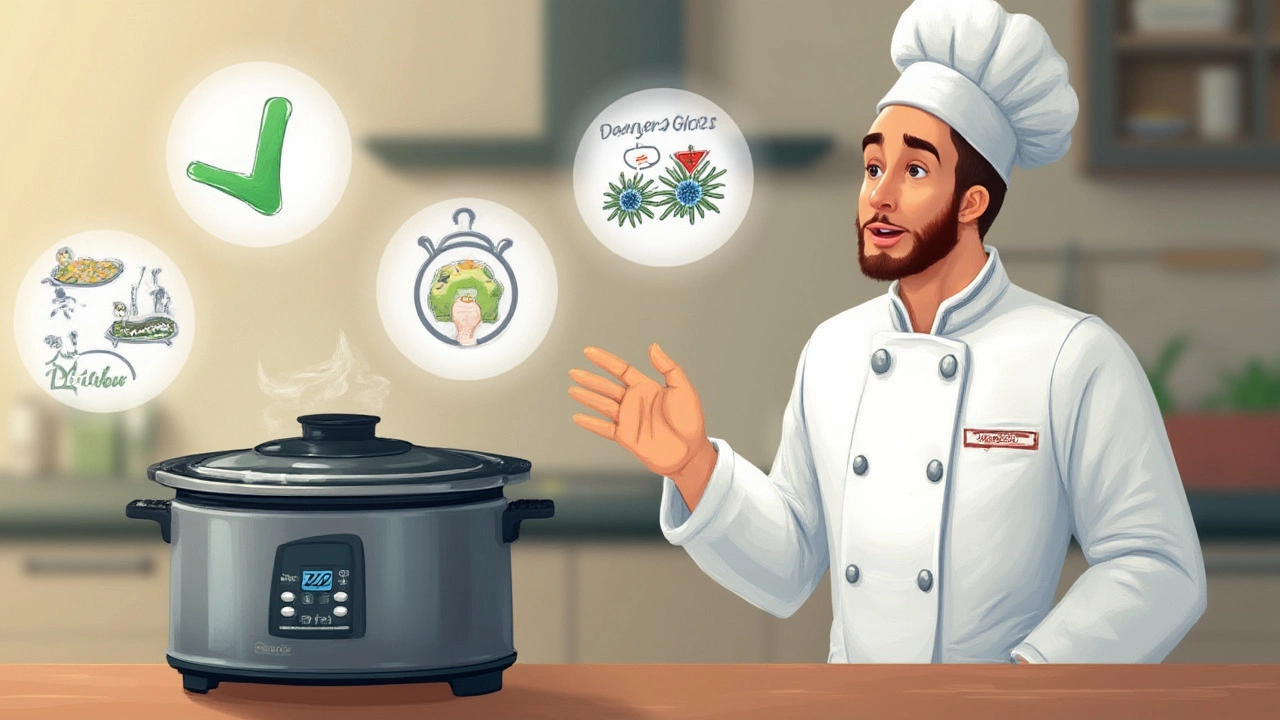
Common Mistakes and Myths About Slow Cooker Safety
There are a ton of sticky myths around Crockpot danger zones. For one, there’s the persistent rumor that all slow cookers “kill bacteria right away” because they get so hot. Not true. They’re designed for slow, gentle cooking, but that means there’s a window when bacteria can multiply before the temp finally climbs. Don’t trust the steam cloud alone—use a thermometer.
Another myth? That you can just toss in frozen meat or poultry with no problem. Even big-name recipe sites sometimes push this shortcut, but both the USDA and every Crockpot manufacturer says it’s risky. Frozen blocks cool down the other foods, make it harder for the whole pot to heat evenly, and lengthen the danger zone time. Defrosting meat may not sound exciting, but it’s the single easiest way to make sure your meal is safe.
People also love to believe that you can just press ‘Warm’ and treat it like a slow-cook shortcut. Unfortunately, the ‘Warm’ function is exactly what it says: for keeping things warm after cooking, not for actual cooking. It’s safe for storing food that’s already above 140°F, but unsafe for starting from raw or cold ingredients. Using ‘Warm’ to cook is one of the fastest ways for food to hang out in the danger zone.
Here’s a list of some other slip-ups that can land your Crockpot meal in the danger zone:
- Taking the lid off too often in the first hour.
- Cooking big, dense cuts of meat whole instead of cut up.
- Leaving leftovers in the Crockpot overnight, even on ‘Warm’.
- Not checking the actual temperature with a thermometer.
- Underfilling or overfilling the Crockpot.
The easiest way to stay safe is to follow a reliable recipe, prep your ingredients like you would if a health inspector was watching, and double check with a simple kitchen thermometer. While there’s a lot of flexibility and creativity in slow cooking, the danger zone isn’t the place to experiment.
If you remember just one thing, remember this: hit 140°F or higher in two hours, and you can rest easy while the stew gets tender. Skip that step and you’re rolling the dice, whatever the recipe calls for.
